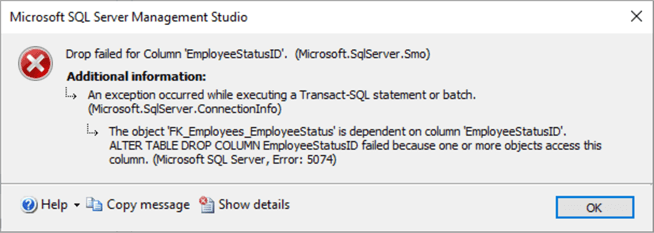
- #Alembic sqlite drop column error full
- #Alembic sqlite drop column error code
- #Alembic sqlite drop column error password
These ORMs also have tools to make the connections or relations between tables or entities.

And the value of that attribute could be, e.g. With an ORM, you normally create a class that represents a table in a SQL database, each attribute of the class represents a column, with a name and a type.įor example a class Pet could represent a SQL table pets.Īnd each instance object of that class represents a row in the database.įor example an object orion_cat (an instance of Pet) could have an attribute orion_cat.type, for the column type.
#Alembic sqlite drop column error code
ORMs ¶įastAPI works with any database and any style of library to talk to the database.Ī common pattern is to use an "ORM": an "object-relational mapping" library.Īn ORM has tools to convert (" map") between objects in code and database tables (" relations").

The FastAPI specific code is as small as always.

Notice that most of the code is the standard SQLAlchemy code you would use with any framework.
#Alembic sqlite drop column error password
The same questions arise from attempt 1, do I need to do this outside of my context processor? Do I need to do more engine configuration?Īny help or direction is greatly appreciated.OAuth2 with Password (and hashing), Bearer with JWT tokensĬreate SQLAlchemy models from the Base classĬreate Pydantic models / schemas for reading / returning Results in the same error as above: INFO Context impl SQLiteImpl. Just to be sure though, I tried to migrate again: $ flask db migrate
#Alembic sqlite drop column error full
I don't know if I need to do this outside of my context processor? Maybe it doesn't pull in the engine info? Maybe I need to bind the engine? Attempt 2Īfter looking through information about SQLAlchemy engine connection, found here and here, I tried directly dropping the table using my flask shell context processor: make_shell_context():Įngine.execute('DROP TABLE IF EXISTS alembic_version')īut it didn't work, because I can query another table in the database and it returns a full table. I am not well versed in engine configuration, and at this point I'm stuck. My engine creation is in my _init_.py file, and uses memory: engine = create_engine('sqlite://') Okay, so there is an issue with the engine configuration, or something. Execution can not proceed without a database to execute against. When running this function I get the error: : Table object 'alembic_version' is not bound to an Engine or Connection. Version = db.Table('alembic_version', db.metadata,autoload_with=db.engine) If db._table(db.engine, 'alembic_version'): First I tried using this code to remove all tables: #drop alembic_version table So I need to directly access my SQLite database, and remove the table.

My thought is to delete the entry in alembic_version, then I will re-initialize the migrations folder and migrate with: $ flask db init Okay, so I believe that means I deleted the migration file, except the alembic_version table that contains the current migration version thinks it still exists and is trying to reference it. INFO Will assume non-transactional DDL.ĮRROR Error: Can't locate revision identified by '44ab999461f7' I deleted the migration file a while ago, but didn't notice until trying to run a migration on my database recently with: $ flask db migrateĪnd I received the following error message: INFO Context impl SQLiteImpl. I am trying to delete the "alembic_version" file that contains the reference to the missing migration file, but am having trouble doing so. I am using SQLAlchemy in Flask for database commands, and flask-alembic for migrations. I am building a Flask web app, and at some point accidentally deleted a migration file for my SQLite database.


 0 kommentar(er)
0 kommentar(er)
